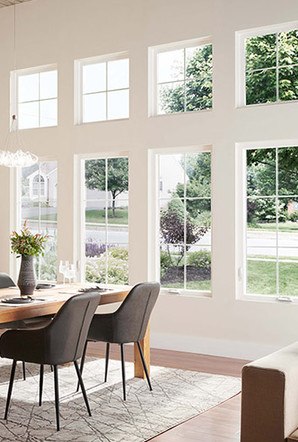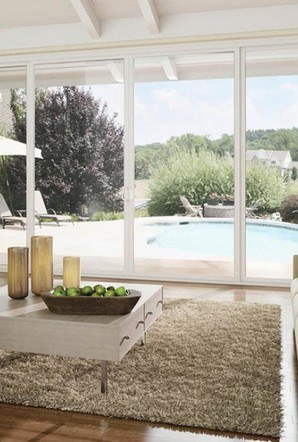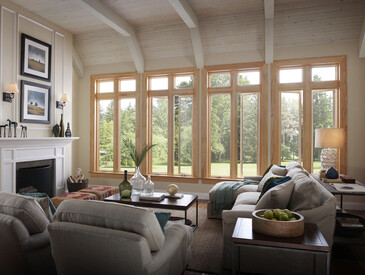Want to expand the living space in your home? A bay or bow window might be the way to go. These windows can provide more space and make a room look larger, without the hassle and cost of putting on an addition. If you’re curious about bow or bay window replacement, read on to get your questions answered. You’ll learn the differences between bow windows vs. bay windows and how to choose the right style for your home.
What Is a Bow Window?
A bow window is a curved window that projects outward from the main walls of a building. Bow windows typically consist of four or more individual windows, which can be fixed or operable, that join together to create a gentle outward arc. This design allows for panoramic views and brings in a significant amount of natural light.
Bow windows are often used in living rooms, dining rooms, and master bedrooms, providing an elegant and spacious feel. Their unique shape can also add an attractive exterior architectural element to a home.

What Is a Bay Window?
A bay window also projects outward from the main walls of a building and forms a “bay” in a room. Bay windows are typically made up of three individual windows, making them more angular in design than bow windows.
Most bay windows consist of a central window parallel to the existing wall (often a fixed picture window), with an operable window on either side set at an angle (often casement windows or single-hung windows). Kitchen bay windows create a sunlit breakfast nook, while den or living room bay windows provide additional seating and double as a cozy reading spot.

Bow Windows and Bay Windows: Benefits of Both
The discussion of bow window vs. bay window isn’t all about differences. In fact, these styles share many of the same benefits. They are one of best ways to increase the square footage of your home without making a radical departure from the original floor plan. These window configurations, also known as protruding windows or “bump-out” additions, work well in a variety of places where you might want a little extra space.
Bay and bow windows also add visual interest to both the interior and exterior walls of your home. This is why bay and bow windows will never go out of style: These edges and angles will not only give your living quarters a sharper look, but also help bring natural light to your space and boost curb appeal.

Bow Windows vs. Bay Windows: The Differences
While bay and bow windows have some similarities, they also have some important differences. Here’s what you need to know when it comes to bow windows vs. bay windows.
Shape
While bow windows are characterized by their smooth, circular appearance and typically feature more windows, bay windows are more pronounced, with angular dimensions, making a distinct visual statement both inside and out. The other key difference is that bay windows expand out farther from the house than bows. Bow windows are typically 15 degrees or less, whereas it’s not unusual for a bay window to be set at 45 or 90 degrees.
Architectural Styles
The continuous curve of a bow window provides a softer and more subtle extension to the exterior. This style is often used in Victorian homes and other classic styles to add elegance and graceful form. Bay windows offer a more dramatic architectural statement with their angular protrusion. They’re commonly associated with modern, contemporary, and Craftsman styles, providing a strong visual point of interest.
Interior Feel
On the interior of the home, the curve of a bow window creates a rounded protrusion in a room, offering a panoramic view and making the space feel more open and inviting. They’re a good choice for any room with a view. The angular configuration of a bay window often creates a distinct nook that makes a good seating area, dining space, or cozy reading corner, adding functional space to the room.
Light and View
The curvature of a bow window allows for more light to enter from different angles, giving a room ample sunlight throughout the day and broader, more sweeping views outside. While they also enhance light and views, the more direct angles of bay windows focus the light and views into more specific areas, which can make a striking focal point but with slightly less overall light diffusion than bow windows.
While bay and bow windows have some similarities, they also have some important differences. Here’s what you need to know when it comes to bow windows vs. bay windows.
Shape
While bow windows are characterized by their smooth, circular appearance and typically feature more windows, bay windows are more pronounced, with angular dimensions, making a distinct visual statement both inside and out. The other key difference is that bay windows expand out farther from the house than bows. Bow windows are typically 15 degrees or less, whereas it’s not unusual for a bay window to be set at 45 or 90 degrees.
Architectural Styles
The continuous curve of a bow window provides a softer and more subtle extension to the exterior. This style is often used in Victorian homes and other classic styles to add elegance and graceful form. Bay windows offer a more dramatic architectural statement with their angular protrusion. They’re commonly associated with modern, contemporary, and Craftsman styles, providing a strong visual point of interest.
Interior Feel
On the interior of the home, the curve of a bow window creates a rounded protrusion in a room, offering a panoramic view and making the space feel more open and inviting. They’re a good choice for any room with a view. The angular configuration of a bay window often creates a distinct nook that makes a good seating area, dining space, or cozy reading corner, adding functional space to the room.
Light and View
The curvature of a bow window allows for more light to enter from different angles, giving a room ample sunlight throughout the day and broader, more sweeping views outside. While they also enhance light and views, the more direct angles of bay windows focus the light and views into more specific areas, which can make a striking focal point but with slightly less overall light diffusion than bow windows.

Bay and Bow Window Operating Styles
Bay and bow windows are more versatile than you might think, but each style does have preferable operating styles. Bay windows that open can be single-hung, double-hung, casement, or sliding, while still adhering to the classic look. Moreover, although it’s not standard, you could put a movable window in the center or fixed windows on the side. The only limits are your own imagination.
Bow windows tend to have even more variations than bays. The windows in a bow are often the same size, and they can be single-hung, double-hung, sliding, casement, or some other kind of window. It’s entirely up to you. Indeed, you could even mix it up by putting, for example, single-hungs on the edges and fixed windows in the interior of the bow.

Bay and Bow Window Grids and Glass
Regardless of whether you choose a bay or bow window, you can add to its aesthetic by selecting the right window grid option. Depending on your preference, your bay or bow window can have Colonial, diamond, drop, or myriad other grid designs. Modern windows also come with a variety of glass options, including double- and triple-paned glass, tempered glass, energy-efficient coatings, and more.
Bay and Bow Window Configurations
The window configuration may affect the operating style you choose, so familiarize yourself with these common terms before shopping.

Oriel Windows
As you’re perusing literature on bay windows, you’ll invariably see the term “oriel window.” Oriel windows are bay windows that do not touch the ground. They’re supported by brackets or other supports, and the window bay is therefore smaller. They’re often found on upper floors, although they can be installed on ground floors.
Canted Windows
Canted windows are standard bay windows that are usually found on the first floor. These windows are sometimes referred to as “classic bay windows,” because they nearly always feature the traditional window configuration (one fixed window flanked by two smaller windows).
Box Bay Windows
Box bay windows, also sometimes called square bay windows, are typically rectangular bump-outs set at 90-degree angles to each other and to the wall. There’s no set number of windows: You can find examples that have one, three, four, or even more windows. Box or square bay windows are popular on more traditional homes like the Colonial style.
Circle Windows
Circle windows aren’t as common as other styles, but they do project a certain charm. With circle windows, an actual circle is created on the inside by using mulled windows at an X angle. The more windows and angle the bow has, the more it resembles a circle.
Can You Change a Normal Window to a Bay Window?
Yes, you can convert a standard window style into a bay window or a bow window. It’s just a matter of adding space that juts out from the wall. Most remodelers have the equipment and the expertise to replace a standard window with a bay window. With the right expertise, you can also use a bow window replacement in a bay window and vice versa.
Bow Windows vs. Bay Windows: Which Will You Choose?
Both bay and bow windows offer unique benefits and can dramatically enhance the livability and appearance of your home. In the discussion of bow windows vs. bay windows, the choice that’s best for you often comes down to the architectural style of the home, the desired use of the space inside, and simply your personal preference.
Still having trouble choosing? Take a look at our Inspiration Gallery to get an idea of what each window style looks like. Then find a Certified Dealer in your area and visit their showroom to see quality MILGARD products for yourself. Our experts can help you find what’s right for your home.





































